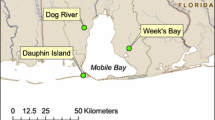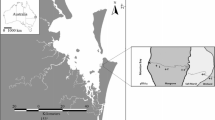Abstract
Measuring fluxes of greenhouse gases (GHGs) is fundamental to estimating their impact on global warming. We examined diurnal variations of carbon dioxide (CO2), methane (CH4), and nitrous oxide (N2O) vertical fluxes in a tidal marsh ecosystem. Measurements were recorded on neap and spring tide days in April and September 2010 in the Shanyutan wetland of the Min River estuary, southeast China. Here, we define a positive flux as directing into the atmosphere. CH4 fluxes on the diurnal scale were positive throughout, and CH4 emissions into the atmosphere on neap tide days were higher than on spring tide days. CH4 releases from the marsh ecosystem on neap tide days were higher in the daytime; however, on spring tide days, daily variations of CH4 emissions were more complex. The marsh ecosystem plays a twofold role in both releasing and assimilating CO2 and N2O gases on the diurnal scale. Average CO2 fluxes were positive on the daily scale both on neap and spring days and were greater on the neap tide days than on spring tide days. Diurnal variations of N2O fluxes fluctuated more. Over the diurnal period, soil temperature markedly controlled variations of CH4 emissions compared to other soil factors, such as salinity and redox potential. Tidal water height was a key factor influencing GHGs fluxes at the water–air interface. Compared with N2O, the diurnal course of CO2 and CH4 fluxes in the marsh ecosystem appeared to be directly controlled by marsh plants. These results have implications for sampling and scaling strategies for estimating GHGs fluxes in tidal marsh ecosystems.





Similar content being viewed by others
References
Alongi, D. M. 1998. Coastal ecosystem processes. Boca Raton: CRC.
Altor, A.E., and W.J. Mitsch. 2008. Pulsing hydrology, methane emissions and carbon dioxide fluxes in created marshes: A 2-year ecosystem study. Wetlands 2008(28): 423–438.
Börjesson, G., and B.H. Svensson. 1997. Seasonal and diurnal methane emissions from a landfill and their regulation by methane oxidation. Waste Management & Research 15: 33–54.
Chanton, J.P., G.J. Whiting, J.D. Happell, and G. Gerard. 1993. Contrasting rate and diurnal patterns of methane emissions from emergent aquatic macrophytes. Aquatic Botany 46: 111–128.
Clough, T.J., L.E. Buckthought, F.M. Kelliher, and R.R. Sherlock. 2007. Diurnal fluctuations of dissolved nitrous oxide (N2O) concentrations and estimates of N2O emissions from a spring-fed river: Implications for IPCC methodology. Global Change Biology 13: 1016–1027. doi:10.1111/j.1365-2486.2007.01337.x.
Crill, P.M., K.B. Bartlett, J.O. Wilson, D.I. Sebacher, R.C. Harriss, J.M. Melack, S. MacIntyre, L. Lesack, and L. Smith-Morrill. 1988. Tropospheric methane from an Amazonian floodplain lake. Journal of Geophysical Research 93: 1564–1570.
De Angelis, M.A., and M.I. Scranton. 1993. Fate of methane in the Hudson River and estuary. Global Biogeochemical Cycles 7: 509–523.
Freeman, C., M.A. Lock, and B. Reynold. 1993. Fluxes of CO2, CH4 and N2O from a Welsh peatland following simulation of water table raw-down: Potential feedback to climatic change. Biogeochemistry 19: 51–60.
Hirota, M., Y.H. Tang, Q.W. Hu, S. Hirata, T. Kato, W.H. Mo, G.G. Cao, and S. Mariloi. 2004. Methane emissions from different vegetation zones in a Qinghai–Tibetan Plateau wetland. Soil Biology and Biochemistry 36: 737–748.
Hirota, M., Y. Senga, Y. Seike, S. Nohara, and H. Kunii. 2007. Fluxes of carbon dioxide, methane and nitrous oxide in two contrastive fringing zones of coastal lagoon, Lake Nakaumi, Japan. Chemosphere 68: 597–603.
Huissteden, D.M.D., J. van Huissteden, A.J. Dolman, and M.K. van der Molen. 2007. The full greenhouse gas balance of an abandoned peat meadow. Biogeoscience 4: 411–424.
IPCC. 2001. In Climate change 2001: The scientific basis, ed. J.H. Houghton, Y. Ding, D.J. Grigg, M. Noguer, P.J. van der Linden, X. Dai, K. Maskell, and C.A. Johnson, 944. Cambridge: Cambridge University Press.
Kaki, T., A. Ojala, and P. Kankaala. 2001. Diel variation in methane emissions from stands of Phragmites australis (Cav.) Trin. ex Steud. and Typha latifolia L. in a boreal lake. Aquatic Botany 71: 259–271.
Kathilankal, J.C., T.J. Mozdzer, J.D. Fuentes, P. D’Odorico, K.J. McGlathery, and J.C. Zieman. 2008. Tidal influences on carbon assimilation by a salt marsh. Environmental Research Letters. doi:10.1088/1748-9326/3/4/044010.
Klinger, L.P., P.R. Zimmerman, J.P. Greenberg, L.E. Heidt, and A.B. Guenther. 1994. Carbon trace gas fluxes along a succession gradient in the Hudson Bay lowland. Journal of Geophysical Research 99: 1469–1494.
Laursen, A.E., and S.P. Seitzinger. 2004. Diurnal patterns of denitrification, oxygen consumption and nitrous oxide production in rivers measured at the whole-reach scale. Freshwater Biology 49: 1448–1458.
Macdonald, K.J., D. Fowler, K.J. Hargreaves, U. Skiba, D. Leith, and M.B. Murray. 1998. Methane emission from a Northern wetland: Response to temperature, water table and transport. Atmospheric Environment 32(19): 3219–3227.
Mikkela, C., I. Sundh, B.H. Svensson, and M. Nilsson. 1995. Diurnal variation in methane emissions in relation to the water table, soil temperature, climate and vegetation cover in a Swedish acid mire. Biogeochemistry 28: 93–114.
Rolston, D.E. 1986. Gas flux. In: Methods of soil analysis, 2nd edition, monograph no. 9, ed. A. Klute, 1103–1119. Wisconsin: American Society of Agronomy and Soil Science Society of America.
Rosenqvist, A., B.R. Forsberg, T. Pimentel, Y.A. Rauste, and J.E. Richey. 2002. The use of spaceborne radar data to model inundation patterns and trace gas emissions in the central Amazon floodplain. International Journal of Remote Sensing 33: 1303–1328.
Roulet, N.T., R. Ash, and T.R. Moore. 1992. Low boreal wetlands as a source of atmospheric methane. Journal of Geophysical Research 97: 3739–3749.
Song, C.C., J.B. Zhang, Y.Y. Wang, Y.S. Wang, and Z.C. Zhao. 2008. Emission of CO2, CH4 and N2O from freshwater marsh in north of China. Journal of Environmental Management 88: 428–436.
Song, C.C., X.F. Xu, H.Q. Tian, and Y.Y. Wang. 2009. Ecosystem–atmosphere exchange of CH4 and N2O and ecosystem respiration in wetlands in the Sanjiang Plain, Northeastern China. Global Change Biology 15: 692–705. doi:10.1111/j.1365-2486.2008.01821.x.
Tamn, F.Y., and Y.S. Wong. 1998. Variations of soil nutrient and organic matter content in a subtropical mangrove ecosystem. Water, Air, and Soil Pollution 103: 245–261.
Tong, C., W.Q. Wang, C.S. Zeng, and R. Marrs. 2010. Methane emissions from a tidal marsh in the Min River estuary, south-east China. Journal of Environment and Health Part A 45: 506–516.
Whalen, S.C., and W.S. Reeburgh. 1990. A methane flux transect along the trans-Alaska pipeline haul road. Tellus 42(B): 237–249.
Whiting, G.J., and J.P. Chanton. 1996. Control of the diurnal pattern of methane emissions from emergent aquatic macrophytes by gas transport mechanism. Aquatic Botany 54: 237–253.
van der Nat, F.J.W.A., J.J. Middelburg, D. van der Meteren, and A. Wielemakers. 1998. Diel methane emission patterns from Scirpus lacustris and Phragmites australis. Biogeochemistry 41: 1–22.
Verville, J.H., S.E. Hobble, F.S. Chapin, and D.U. Hooper. 1998. Response of tundra CH4 and CO2 flux to manipulation of temperature and vegetation. Biogeochemistry 41: 215–235.
Yamamoto, A., M. Hirota, S. Suzuki, O.E. Yusuke, P.C. Zhang, and S. Mariko. 2009. Effects of tidal fluctuations on CO2 and CH4 fluxes in the littoral zone of a brackish-water lake. Limnology 10: 229–237.
Yavitt, J.B., and A.K. Knapp. 1998. Aspects of methane flow from sediment through emergent cattail (Typha latifolia) plant. New Phytologist 139: 495–503.
Zhang, Y.H., and W.X. Ding. 2011. Diel methane emissions in stands of Spartina alterniflora and Suaeda salsa from a coastal salt marsh. Aquatic Botany 95: 262–267.
Zheng, X.Z. 2010. Changes in nitrogen and phosphate and eutrophication character in the Min River estuary. Journal of Oceanography in Taiwin Strait. 29: 42–46 (in Chinese).
Acknowledgments
This work was financially supported by grants from the National Science Foundation of China (nos. 41071148 and 40671174) and the Key Discipline Construction Foundation for Physical Geography of Fujian Province. We thank Ze-Xiong Liu, Yu-Feng Jin, Xu-Wei Li, Shi-Quan Yong, Peng Ma, Ming-Hui Li, Lin-Lin Tian, and Yue-Xin Fan for their field assistance. We would sincerely like to thank the associate editor and two anonymous reviewers for their valuable comments and suggestions that have improved the manuscript greatly. We also thank Lisa Martin for her help with the language editing on this article.
Author information
Authors and Affiliations
Corresponding author
Rights and permissions
About this article
Cite this article
Tong, C., Huang, J.F., Hu, Z.Q. et al. Diurnal Variations of Carbon Dioxide, Methane, and Nitrous Oxide Vertical Fluxes in a Subtropical Estuarine Marsh on Neap and Spring Tide Days. Estuaries and Coasts 36, 633–642 (2013). https://doi.org/10.1007/s12237-013-9596-1
Received:
Revised:
Accepted:
Published:
Issue Date:
DOI: https://doi.org/10.1007/s12237-013-9596-1




